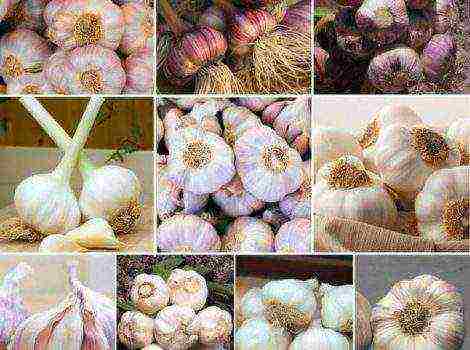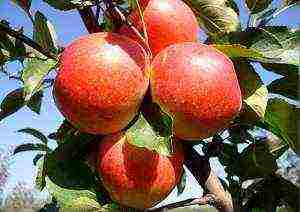Content
- 1 Pavlovsky
- 2 Meyer
- 3 Chinese
- 4 Anniversary
- 5 Genoa
- 6 Lisbon
- 7 Maikop
- 8 Buddha's hand
- 9 Ponderosa
- 10 Volcano
- 11 Lunario
- 12 Novogruzinsky
- 13 Lemon Care Video
- 14 Pavlovsky lemon
- 15 Lemon Meyer
- 16 Genoa lemon
- 17 Lemon Eureka
- 18 Maykop lemon
- 19 Lemon Grade Buddha Hand
- 20 Ponderosa lemon
- 21 Lemon variety Lisbon
- 22 Villa Frank Lemon
- 23 Irkutsk lemon
- 24 Lemon variety "Pavlovsky"
- 25 Lemon variety "Meyer"
- 26 Lemon "Chinese"
- 27 Homemade lemon "Jubilee" and its photo
- 28 Genoa lemon
- 29 Lemon "Lisbon"
- 30 Lemon "Maykop"
- 31 Lemon "Hand of Buddha"
- 32 Lemon "Ponderosa"
- 33 Lemon "Lunario" and his photo
- 34 Citrofortunella "Volcano" lemon
- 35 Lemon "Novogruzinsky"
Have you already grown indoor lemon and decided to add to your collection? Or are you just planning to acquire a similar exotic? Let's see which varieties of lemons are best suited for growing in apartments.
Pavlovsky
Lemon tree about 1.5–2 m high with a small rounded crown up to 1 m. Old branches have gray-green bark with small thorns. Leaves are glossy smooth, dark, up to 16 cm in length. They can be oval, rounded or elongated.
It blooms and bears fruit all year round, one of the most unpretentious varieties to care for. Even western and north-western windows are suitable for such a room lemon. It produces from 20 to 40 tasty fruits per year (many argue that they are even tastier than usual) weighing 120–150 g. Sometimes there are specimens up to 500 g. The peel can be eaten together with the pulp, usually 5–10 seeds, occasionally 20. Often found fruits without seeds. This lemon variety begins to bear fruit at 3-4 years of age.
It is relatively resistant to dry air, but reacts very well to spraying the crown. The ideal humidity for him is 60–80%. In the house, it is usually grown near the eastern windows, although it can tolerate partial shade. But on the south window, burns are possible.
Meyer
Widespread for outdoor cultivation, where it is often grafted. In the apartment it is grown on its own roots. The height of the tree is from 1 to 1.5 m. The crown is well leafy and easy to form. There are few thorns. Leaves are glossy, dense and dark, serrated.
Refers to remontant and early ripening varieties, bears fruit abundantly, sometimes up to 4 times a year. Fruits are not very sour, up to 150 g. Buds appear only on young shoots released this year. It blooms earlier than other species, most often already in March or April. The flowers are small (3-4 cm), but very fragrant. They can be located singly or in inflorescences of 2-6 pcs. Ripening lasts 8-9 months, the fruits are removed slightly unripe.
These homemade lemons must be carefully cared for: in winter they must be kept in a room where the temperature is no more than 12 ° C, otherwise the fruit may not set. They need regular watering and spraying of the crown. It is better to grow such a lemon near the east or west windows: the abundance of light will make the tree grow quickly, but will slow down the setting of flowers. Blackout is also harmful - leaves may begin to fall from it. It is necessary to protect from drafts. Meyer can be grown from both cuttings and seeds.
Chinese
In fact, this is the second name of Meyer's lemon: this variety was brought from Beijing (for which it received the name "Chinese") by the researcher Franz Meyer (in whose honor the variety received the first name).
Anniversary
A hybrid bred in Uzbekistan, the "ancestors" of which were such lemon varieties as Tashkent and Novogruzinsky lemon. One of the most undemanding varieties to care for. Lemon Jubilee usually grows up to 1.5 m. It is a large-fruited variety (fruits up to 600 g). The skin is thick. This homemade lemon attracts many with its abundant flowering, during which the tree is almost entirely covered with white flowers with a slightly purple tint (also a "hereditary" feature of the variety from Tashkent).Usually they are collected in inflorescences of 14-16 pcs.
Like the variety bred in Tashkent, it begins to bear fruit for 3-4 years. It adapts quickly and easily tolerates room conditions: even in dry air and with low watering, fruits are set. True, it is difficult to obtain cuttings for propagation from this variety of indoor lemons: branches with buds are formed from almost every bud and leaf sinus.
Genoa
One of the rare species. Trees about a meter with a dense crown. There are almost no thorns. These lemons are distinguished by their particularly tasty fruits with delicate pulp. Their peel is edible, without bitterness.
Rather dense films inside are characteristic. Weight reaches an average of 110 g. The lemon grown from the cuttings begins to bloom in the 4th year. One of the important conditions for care is an abundance of light, without which the tree does not develop well. With good home care, it gives a huge harvest: in the first years of fruiting, it brings up to 50 fruits, and from an adult tree they can be harvested in about 120-180 a year.
Lisbon
Tall trees with large, dense and wide leaves. There are many thorns. The fruit is very tasty, seedless, with a thin edible skin, weighing 120–150 g. Very hardy variety. It develops well at almost any room temperature, it is resistant to heat and cool, as well as drought. Lighting loves bright, but diffused - direct rays of the sun should not fall. As a rule, it begins to bear fruit as early as 2-3 years. From this lemon tree, you can harvest up to 60 pieces in a season.
Maikop
The best varieties have been used for breeding this lemon. The result is an extremely productive crop: mature trees produce 100-300 fruits per year, and sometimes up to 700 are removed from old lemon trees of this variety! The fruits weigh about 140-160 g.
Trees rarely grow taller than 2 meters. They are hardy and unpretentious, home conditions are well suited for them. There are two subspecies. The first type is formed almost without stamping. The crown is dense, branched, with many branches without thorns, which are located horizontally or hang down slightly. Leaves with a waxy bloom, dark. Small flowers are collected in inflorescences of 3-5 pcs. It normally tolerates wintering in houses and ordinary indoor conditions.
The second variety is distinguished by strong, semi-vertical branches directed upwards. The crown is symmetrical. This type easily adapts to home conditions, but prefers wintering in a cool room.
Buddha's hand
If you wanted to know which lemon is the most original, then this is without a doubt the Hand of Buddha. Such indoor lemon is usually obtained for its decorative qualities. Most of all attention is attracted by its fruits: long, up to 40 cm, in the form of a bunch of bananas or a hand (for which the variety got its name). They consist mainly of a thick peel up to 5 cm, the pulp is very little, it is not juicy, has a bitter or very sour taste and is not suitable for eating, however, the zest is sometimes used for baking.
The leaves are oval and rather large. Home care requires plenty of light and warmth. Begins to bear fruit in the 3rd year. The fruits have a slight scent of violets. Sometimes this tree is used in perfumery.
Ponderosa
A hybrid that came naturally from crossing between species such as citrons and lemons (according to some versions, like the New Zealand variety). It has similarities with the Kiev large-fruited. It normally tolerates heat and drought, but before starting such a plant, you need to carefully read the rules for care: the plant is sensitive to soil, reacts poorly to its excessive acidity, needs additional feeding. These lemon trees love diffused glare.
The trunk is up to 1.8 m. Strong branches, a spreading and wide crown, tough and dense leaves are inherent in this lemon. Flowers resemble jasmine - large, like the Kiev lemon, white-cream. Peak flowering in spring, from March to May.Just like the Kiev large-fruited lemon, it bears very large fruits - on average 300-500 g, but there are often cases when they reach 1 kg.
The peel is rough, rather thick. The pulp is juicy, pleasant to the taste, almost without the characteristic aftertaste of citric acid. There are many seeds. Fruiting begins in the 2nd year.
Volcano
Dwarf tree up to 1.2 m. Fruits are miniature (up to 4 cm), tasty, with a gentle sourness. You can decorate your home with these lemon trees, since they bloom all year round, and you can often see flowers and ripe fruits on the branches.
When watering, very soft settled water is important.
Lunario
One of the most successful varieties for an apartment. A tree of 1–1.5 m blooms almost continuously, and ripe fruits ripen on it at any time of the year. Flowers are solitary or in small clusters. The first flowers on these lemons can be found 2-3 years old. There are many thorns.
Fruits with a thin, smooth skin. The pulp is aromatic, not very juicy, slightly acidic. There are almost no seeds.
Novogruzinsky
Novogruzinsky is a vigorous variety, the height can reach 2-3 m. The crown is regular, dense and spreading. Fruiting 2-3 times a year, starting from the 4th (sometimes 5th) year of life.
If the Novogruzinsky lemon is well cared for, it can produce up to 200 fruits per year. Their average weight is 130 g. Fragrant, juicy, sour. Large flowers have a light purple hue, single or in clusters.
Lemon Care Video
In this video, you will hear helpful tips for caring for your lemon.
.
Growing a lemon from a seed is not difficult if you choose the right variety. Flower shops offer a number of those suitable for indoor cultivation.
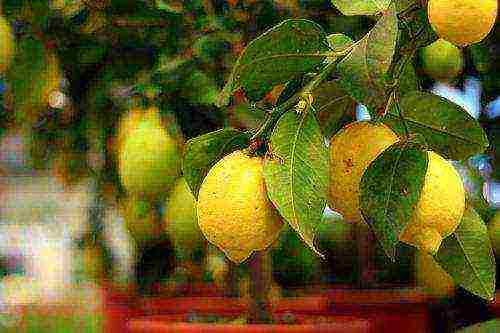
Before buying a lemon tree, you should decide on its variety.
Variety selection criteria
Before purchasing an indoor lemon seedling, you need to determine the purpose of the cultivation. To understand which one you need, the following characteristics will help:
- Fruiting plant.
- Use of fruits for food.
- Shape, color, taste of lemons.
- The presence of thorns on the stem.
- The place where the pot will stand.
- Climate.
If you choose the right variety, it will be easy to care for it. Some varieties of indoor lemons are decorative and do not bear fruit.
Pavlovsky
It is the most suitable lemon for indoor cultivation. The main features of the variety: self-pollination and resistance to lack of sunlight. It grows up to 2 m in height, but with the correct formation of the crown, it will remain small. Young trees bear 20–30 fruits during the fruiting period, and adults produce 50–80 fruits per harvest.
Fruits with a strong but pleasant aroma have almost no seeds. Pavlovsky got its distribution thanks to a rich harvest and unpretentiousness.
The air temperature should not drop below 15 ° C even during wintering, otherwise the plant will shed its leaves. Regular spraying and timely watering are required.
With proper care, it grows 50 cm in height per year.
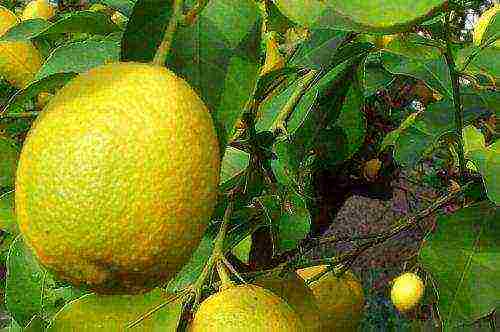
Pavlovsky lemon gives a good harvest
Meyer's lemon
Meyer's lemon is otherwise called Chinese. This dwarf plant is the result of crossing a lemon and an orange.
Meyer's peculiarity lies in the fruits: they are small and less sour in taste than regular lemons. The peel is thin, yellow-orange, shines beautifully.
Meyer is perfect for indoor cultivation, since the average growth of a shrub is less than 1 m. It bears abundant fruit already in the first year after planting. The flowers resemble large clusters of purple. Needs regular spraying and watering, loves sunlight, so you need to take care of extending daylight hours in winter.
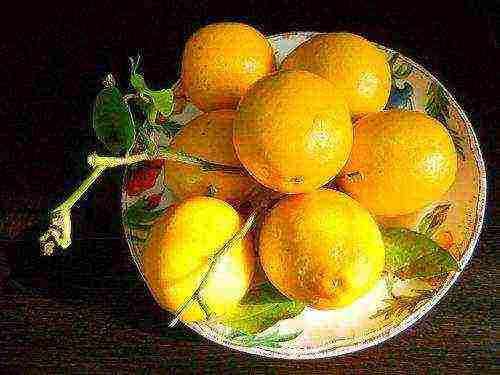
Meyer's lemon - a hybrid of lemon and orange
Maikop
This is the result of the hard work of breeders. For years, scientists have perfected homemade lemon and selected only the best seedlings, so it combines the best of homemade lemon trees.Reaches 2 m in height, adapted for growing in apartments, gives a large harvest. Scientists distinguish between two varieties of the Maikop lemon variety:
- The tree has no part of the trunk between the root collar and the first branch. The branches are horizontal, heavy, drooping as they grow. There are no spines on the trunk and branches. Dark green leaves have an even rim and shine. No more than five flowers per inflorescence. Fruits are elongated with a thin rough skin. Fruit taste is moderately sour.
- Symmetrical crown and branches directed upwards. Spines are absent, leaves are covered with thick dark veins. Flowers are arranged singly. Fruits with a thin skin and small ribs on the surface.
Any of the subspecies of the Maykop lemon gives a large harvest: one tree can bear more than 300 fruits in one year.
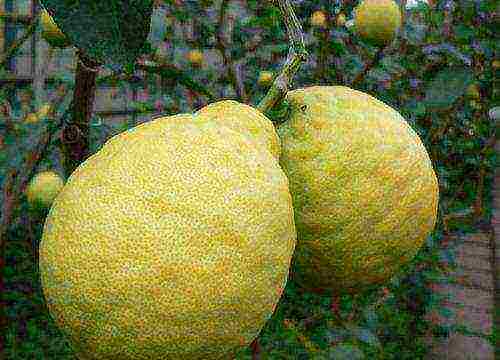
Maykop lemon gives many large fruits
Genoa
This popular variety can be easily grown in an apartment and get a stable harvest. The pulp of a ripe lemon is soft and juicy, has a pleasant delicate taste, but the partitions dividing the slices are hard and do not detach well from the pulp. The green-yellow rind is thick and rough, edible. When buying a seedling, you should pay attention to the leaves:
- Bright green color.
- Large, can reach dimensions of 10x6 cm.
- Petioles are wingless and without pubescence.
- Oval, slightly pointed (egg-shaped).
The trees are medium in size and have a beautiful branched crown. There are no thorns on the lower branches and trunk of the tree, but they appear on the upper shoots.
Bears fruit in the fourth year after planting and yields a large harvest. It is sensitive to lack of sunlight, so it is best to place the plant pot on the southern windows.
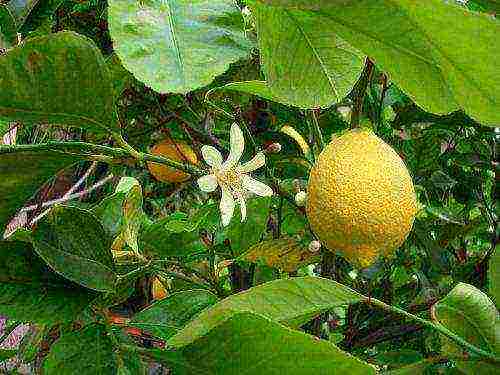
Genoa lemon grows well at home
Eureka
The lemon variety grown in California has good low temperature tolerance. The fruits are large, with thick skin, and have a pleasant taste. Used in cooking and making cocktails. Ribbing and slight roughness are often found on the surface of the peel. Fruits are light yellow in color with pinkish flesh.
It is easy to determine the type of lemon Eureka by the leaves and buds: the leaves are variegated, and the inflorescences are bright purple. Begins to bear fruit in the first year after planting. It rarely grows more than 2 m, which allows the plant to be grown even in small greenhouses or on a windowsill.
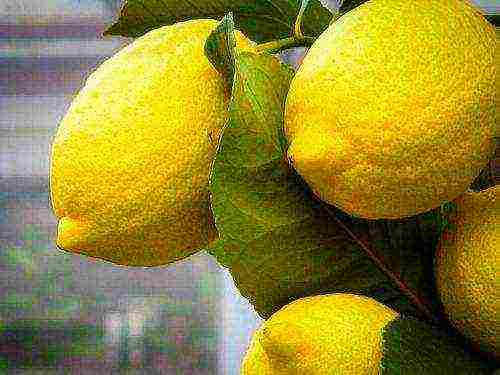
Lemon Eureka - Californian variety
Volcano
Lemon of the Vulkan variety is a hybrid plant obtained by crossing a kumquat and a lemon, and has much in common with the Pavlovsky variety. There are no exact differential signs for determining the grade of the volcano, and under this name in stores you can find lemons of the Turkish subgroup and hybrids of mandarin or kumquat.
Volcano fruits are rarely used for food because of their unpleasant taste, so the plant is decorative in nature.
If the owner needs a plant with a similar look, but edible fruits, then it is worth planting Pavlovsky lemon.
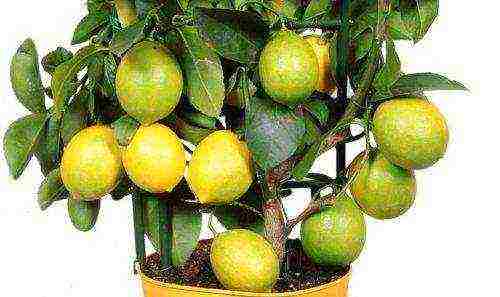
Lemon Volcano produces inedible fruits
Mezensky
It is used as an ornamental variety, since the fruits have an unpleasant bitter-sour taste. The trees are small in size, and if the crown is not formed in time, they have an untidy appearance. The crown grows strongly in width, but not in height.
The Mezen variety has wide leaves, dense in structure, reaching at least 20 cm in size. Inflorescences differ from Turkish varieties in bright purple color and a weak lemon odor. This variety differs from others by the presence of thorns on the trunk and branches.
New Zealand
Scientists have not been able to clearly identify the ancestors of the variety, since it is similar to many citruses. Closest to citron: the plant has spines and narrow winged leaves, large flowers.
Fruits are medium in size and ovoid. Fruit nipple is wide and elongated. The skin is thick and bumpy, ranging from yellow to orange in color. The pulp of the fruit is juicy and very sour, and is loose in structure. There are few seeds in the fruit; more than four seeds per fruit are rare.

New Zealand lemon produces large fruits with few seeds.
Kiev large-fruited
It is widely known for its high yield. It blooms and bears fruit all year round. The variety is unpretentious, easily adapts to indoor survival.
The beautiful crown is decorated with flowers and fruits all year round. If you form it correctly, you can increase the yield and affect the weight of the fruits: they often weigh about 1 kg. Thin peel and pleasant aroma, there are practically no seeds. The leaves are wide and large, there are no thorns.
Trees can be kept outdoors in summer and brought into the apartment in winter. Kiev large-fruited variety is suitable for greenhouse cultivation in the open field or in small tubs in a greenhouse.
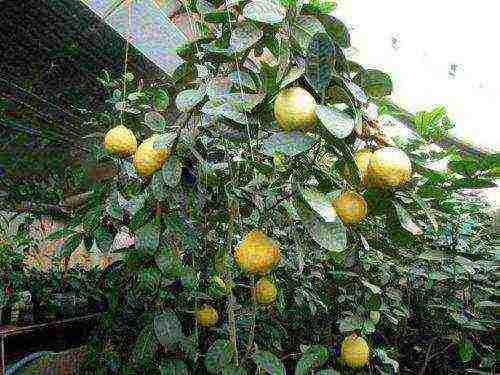
Kiev large-fruited gives lemons up to 1 kg in weight
Ponderosa
Large hybrid form of lemon, obtained by crossing a lemon and a pomelo. Has characteristics characteristic of each culture. Due to the large size of the fruit, flower growers often confuse it with the Kiev large-fruited, but there are differences.
Ponderoza perfectly adapts to growth in apartments, tolerates drought and heat well. Soil oxidation immediately affects the state of the leaves.
The main feature of the variety is the shape of the crown: it is bushy with powerful branches. Leaves are dense and hard, round, small.
Beige flowers with a pleasant aroma are collected both in inflorescences and singly on the tree trunk, therefore, bloom should be monitored so that single flowers do not interfere with the formation of leaves.
Ponderosa grows slowly, so fruiting begins only in the second year after the rooting of the cuttings. The harvest is small but stable.
The fruits are large, I can weigh 1.5 kg. The pulp of the fruit is tender, easily separated from the veins and membranes. The acidity of the pulp is practically absent, but there is a lot of vitamin C. There are many seeds, but the plant reproduces only by cuttings. The rind is dense and fleshy, like a pomelo, bumpy with a bitter aftertaste.
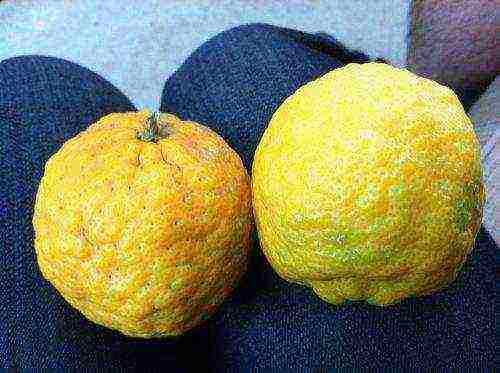
Ponderosa lemon produces very large and tasty fruits.
Lisbon
The most vigorous tree among all varieties of indoor lemons. Gardeners love him no less than others for the yield and beauty of the crown. Lisbon has many large spines that cover the trunk and young shoots. The leaves densely cover all the branches of the tree, have an elongated oblong shape, fleshy. It needs good lighting, so it is necessary to additionally illuminate the tree in winter with fluorescent lamps.
In the second year after rooting, 30–40 fruits are harvested. After a few years, fruiting increases. The crop is harvested 2 times a year: in the middle of winter and at the end of spring. The fruits are oval and bright yellow in color. The skin is thick, covered with deep pores. The pulp is juicy and sour, pitted.
One of the features of Lisbon is the placement of fruits inside the crown, which protects them from the negative effects of various factors.
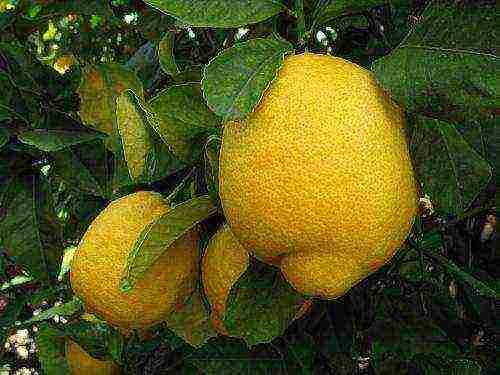
Lemon Lisbon is a very productive variety
Irkutsk large-fruited lemon
Was withdrawn recently. Features of the variety:
- Unpretentious to care for, but requires a lot of light and fresh air.
- Propagated by cuttings.
- Medium sized tree.
- Fruiting in 2 years after rooting.
- Large tasty fruits.
Fruits ripen for more than six months and grow weighing more than 1 kg. Fruits are oval in shape with a pronounced papilla. The skin is thick, covered with small depressions, and has a yellow-green color. The peel is used for food, the pulp is used for making desserts.
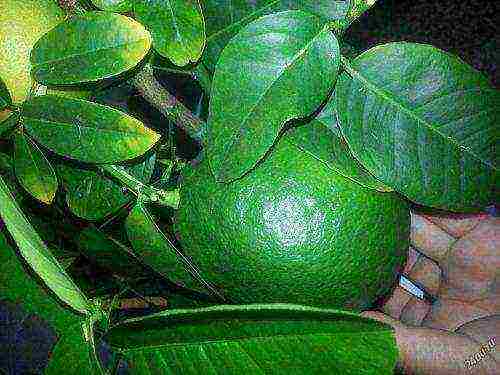
Irkutsk large-fruited lemon bears fruit 2 years after planting
Villafranca
It has a pyramidal shape and powerful branches. Thorns can be seen only on young shoots. The plant is medium-sized, rarely reaches a height of 1.5 meters. The leaves are small, but there are a lot of them on the branches. It blooms with single small flowers or small inflorescences.
Fruits are small in size, round or oval in shape with a pleasant yellow color.Lemons have a smooth surface and reach a mass of no more than 100 g.
The pulp is aromatic and sour. For Russia, this variety is rare, it can be purchased only on order and grown with your own hands from seeds.
Subscribe Be aware of new products on our site
Many people cannot imagine tea without a slice of fragrant lemon, which also adds a special taste to the drink. Citrus fruits are useful, they are rich in vitamin C, help us in the treatment of colds, and raise immunity. Lemons are most often imported to our country from Turkey and Egypt, they go a long way before getting to our table.
People who grow lemon at home will be able to say with confidence how much the aroma of these citrus fruits is stronger. The lemon in the room is grown not only for the purpose of obtaining fruit. It is also a beautiful indoor plant with glossy leaves, it brings positive energy to the room, exudes useful phytoncides. Lemons ripe at home will become a real joy for children and an amazing exotic for guests. Should you grow lemon at home, and which variety should you choose?
Pavlovsky lemon
This variety got its name due to the fact that it was bred about 100 years ago in the village of Pavlovo, Nizhny Novgorod region. It is considered one of the best and most suitable for indoor growing.
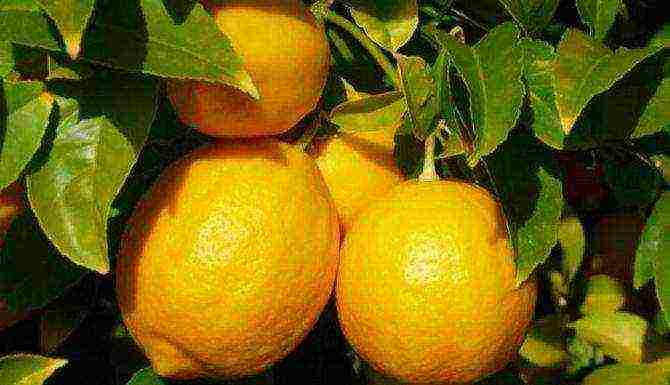
Pavlovsk lemon is the most popular home grown
The main advantages are self-pollination and resistance to lack of sunlight. Most lemons do not tolerate direct sunlight, so the pot should be placed on the west or east side. However, diffused light is vital for the plant.
"Pavlovsky" can grow up to 2 meters, so you need to optimally select the space for it. It produces 20 to 80 fruits per year, depending on age. The plant bears fruit already in the first year, but it is better to remove the ovary before reaching the age of three, so as not to weaken it. The Pavlovsky lemon grows quickly - up to 50 centimeters per year.
The main conditions for this variety are high humidity, heat not lower than 20 degrees, watering and spraying. In the summer, you cannot take it outside, otherwise the plant may shed its leaves. Ripe lemons are recommended to be cut off immediately, otherwise they become unusable, although they can hang on the tree for up to a year. Fruits are fragrant, slightly sweet, some are seedless.
Lemon Meyer
Introduced back in 1929, it is considered a dwarf. It gives a good harvest even in the open field, therefore it is popular. The tree reaches a height of 1–1.5 meters. The flowers are fragrant and bloom all year round.
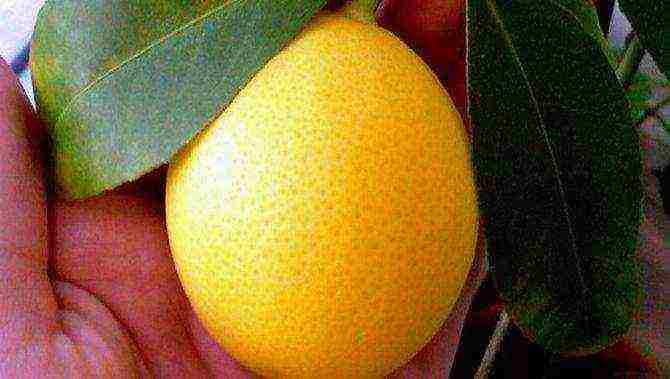
Meyer lemon variety
The main conditions are abundant diffused light, watering and spraying, drainage, top dressing. The plant does not tolerate cold, climatic changes and drafts; in winter it can shed its leaves. For the winter period, this kind of lemon is removed in a cool room.
Fruits with a thin skin, have a strong aroma, they are sour, there are seeds. The fruit can be removed from acid by intensive watering (2 times a week).
Genoa lemon
The main advantage of this lemon variety is that the fruits are of the highest quality, they have a pleasant, juicy pulp and an edible rind. The plant bears fruit well, at maturity it gives a large number of fruits. Lemon begins to bear fruit at 4 or 5 years.
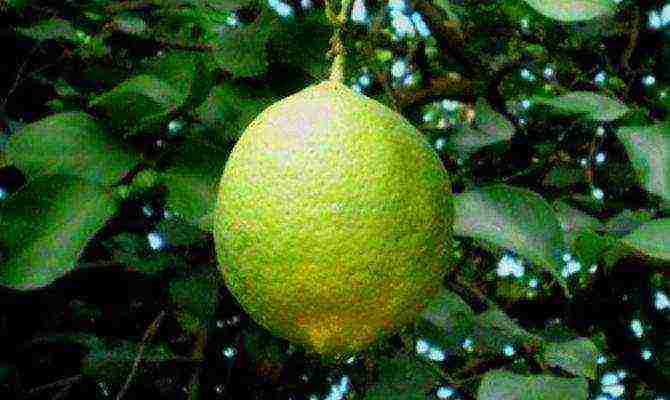
Lemon Genoa
The main conditions for keeping this plant are an abundance of diffused light, southeast windows.
The variety is considered rare, the tree reaches a height of 3 meters. There are no thorns on it, it blooms several times a year.
Lemon Eureka
Eureka lemon will become a real exotic at home. The fruits are striped, the buds are purple, the leaves are variegated. The flesh of the fruit is also unusual - it is pink. The main disadvantage is the low fruiting of the plant. The fruits are very sour, but juicy, with seeds.
Maykop lemon
The variety appeared thanks to improvement by folk breeders. The plant bears fruit very well, up to 300 lemons per year. Some breeders managed to get up to 700 fruits. (this is possible only in a greenhouse)
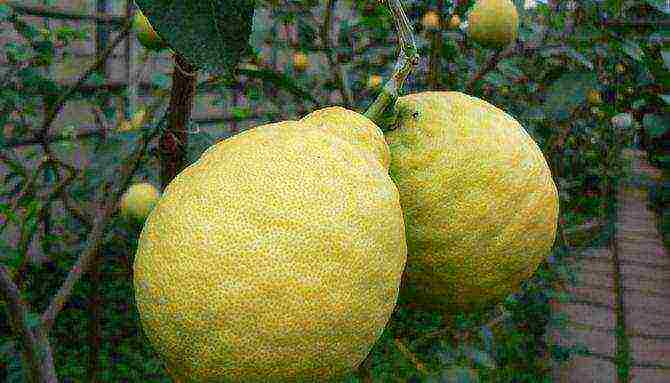
Maykop lemon
The advantage is that lemon is unpretentious, it tolerates winter normally in cool rooms. There are several varieties of this lemon. The fruits are fragrant and large, juicy, weighing up to 140 grams.
Lemon Grade Buddha Hand
Another unusual lemon is the Buddha's Hand. It will attract attention with its unusual shape of the fruit, which resembles a hand with long fingers. The main disadvantage is that the fruit is not edible, as it is bitter and dry.
This variety is used more in confectionery. It is rarely grown indoors because of the whimsical nature and height of the tree (1-3 meters).
Ponderosa lemon
The variety appeared due to the fact that a lemon and a pomelo were crossed. The taste turned out to be hybrid (there is no usual acid, the pulp is tender), but the fruits are large, they can weigh up to 1 kilogram. The lemon of this variety has a lot of seeds.
The plant is not very whimsical, it tolerates heat. It is important to monitor the soil, its acidity, and fertilize ponderose in time.
Lemon variety Lisbon
The plant reaches a height of 2 meters, it is considered a fast growing tree. The fruits have a high taste - they grow up to 200 grams in weight, the pulp is sour and juicy, pitted lemons.
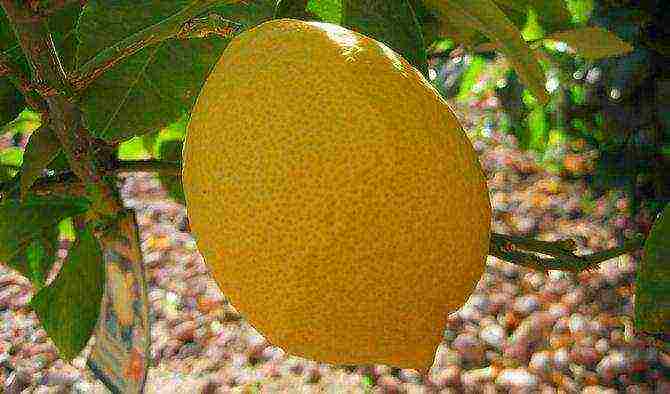
lemon grade Lisbon
The plant is considered to be fruitful, well tolerant of cold and heat, wind.
Villa Frank Lemon
A tree of medium height, without thorns, gives a small yield - no more than 5 flowers per plant, and accordingly fruits. The average fruit size is 100 grams, it is juicy and sweetish. The variety is demanding in care, needs the right light regime.
Irkutsk lemon
A kind of lemon with large fruits, they reach a weight of one and a half kilograms. The plant is not picky, it does not require frequent pruning, bears fruit 2 times a year. The flowers are large and beautiful, collected in inflorescences.
Slightly similar to this variety and "Kievskiy krupnoplodny", which is distinguished by the need to form a crown. Both types of lemon are often used in interior decoration, as they have beautiful large leaves and flowers. The flowers are also very fragrant.
When choosing a lemon variety, you should be guided by such basic criteria - what is more important, decorative qualities or yield, fruit taste. It is also important to navigate in conditions that can be optimally maintained for a particular variety.
As you know, it is not easy to grow a whimsical lemon in a room environment. This requires the optimal creation of growing conditions close to tropical, as well as timely, regular care. Of great importance in the cultivation of citrus is its variety.
In Russia, the most common are low and medium-sized varieties of lemons. These include Pavlovskiy, Kurskiy, Villa Franka, Maikopskiy, Lisbon, Nizhegorodskiy, Genoa, Eureka, Novogruzinskiy, Ponderoza, Yubileiny, Lunario and others.
The varieties of indoor lemons differ not only in the height of the tree, but also in their adaptability to growing conditions, the size and taste of the fruit. So some types of lemon have a fruit color from yellowish to greenish-yellow, others - from rich yellow to orange. Dwarf trees have a compact, beautiful crown, abundantly decorated with flowers and fruits, therefore they are especially decorative.
Photos of some varieties of lemons are posted in the gallery below:
Lemon variety "Pavlovsky"
Lemon "Pavlovsky" - a variety of national selection. Bred in the village of Pavlovo, Nizhny Novgorod region more than 100 years ago. It is a leader among other types of indoor lemons, because, unlike its congeners, it is unpretentious, grows well and bears fruit even on the western and north-western windows. Tolerates shade and dry air. Flowering and fruiting last throughout the year.
Pavlovsk lemons reach 1.5-2 m in height. Their crown is round, compact, up to 1 m in diameter. The bark on old branches is gray or greenish, with longitudinal cracks and small brown thorns. The leaves are dark green, dense, with a smooth, shiny, even surface. Their length varies from 13 to 16 cm, width from 5 to 9 cm. In shape, leaf plates can be oval or oblong. There are specimens with broad-ovate leaves. The lifespan of one leaf is 2-3 years.
The yield of one adult tree is 20-40 fruits per year. The fruits have high taste, their characteristics are superior to lemons grown in the south in the open field. They are often seedless, or contain 5-10, rarely 20 seeds. Fruit rind is smooth, shiny, slightly rough or slightly lumpy, 4-5 mm thick. It is eaten together with the pulp. Has a pleasant, sweet taste. Fruit length - 10 cm, diameter - 5-7 cm, weight 120-150 g, some specimens reach 500 g.
The Pavlovsky lemon variety begins to bear fruit for 3-4 years. The period of active growth is observed from the end of February to the beginning of June. After that, the tree enters into a brief state of dormancy. From mid to late July, the second period of active growth begins. The third wave begins in mid-September and ends at the end of November. Shoots grow 50-80 cm per year.
Lemon "Pavlovsky" prefers places well lit by the sun, but can grow in shade and partial shade. It develops and bears fruit better on the eastern windows. On the south side, its leaves are often burned. The optimum moisture content for this citrus is 60-80%. Frequent spraying of the crown is recommended.
Lemon variety "Meyer"
Lemon "Meyer" has a second name "Chinese". According to one version, it is the result of natural hybridization of lemon and orange. According to another version, it is considered a hybrid of a red-orange Cantonese lemon. It was brought from China to the United States and began to give rich harvests even in the open field, for which it subsequently became widespread in Europe. It appeared in Russia in 1929.
Lemon "Chinese"
Lemon "Chinese" is a low tree, reaching 1-1.5 m. The crown is spherical, densely leafed, with a few thorns. It lends itself well to pruning. Leaves are dense, ovoid, dark green, serrated along the edge. The flowers are small, white, with a purple tint, fragrant, arranged singly or in clusters of 2-6. Flowering lasts all year round, but the tree blooms most abundantly in spring. Fruits are round, with a thin, bright yellow or orange skin, weighing 70-150 g. The pulp is juicy, slightly acidic, slightly bitter.
The yield of this variety is quite high. Fruiting occurs in the 2-3 year of the tree's life. Buds are formed on the shoots of the current year, therefore, in order for the citrus not to lose extra strength, some of the buds should be removed.
Lemon variety "Meyer" stands out among other varieties for early maturity of fruits, abundant fruiting and early flowering (blooms in March - April). Fruits are formed on old branches and shoots of the current year.
Citrus tolerates extreme heat and dry air, however, during the rest period, the air in the room where the tree grows should be humidified. It needs good lighting, so it is recommended to grow it on the south and southeast windows.
It is believed that the lemon "Chinese" has a positive bioenergy, therefore it is used not only to decorate the room, but also for medicinal purposes.
Homemade lemon "Jubilee" and its photo
Lemon "Yubileiny" was obtained in Uzbekistan as a result of inoculation of lemons "Tashkent" and "Novogruzinsky". It is one of the most unpretentious varieties. It is a tree up to 1.5 m high. The leaves are large, dark green, dense, leathery, smooth, broadly oval. Outwardly they resemble the leaves of the Pendoza lemon. They keep on short petioles with small, rounded lionfish. The flowers are white with a purple tint.Collected in inflorescences of 14-16 pieces. Abundant flowering. During this period, the tree turns into a white ball. Fruits are round, large, weighing 500-600 g, with a thick, yellowish skin.
The variety brings high yields. Begins to bear fruit in the 2nd year of life.
Lemon "Yubileiny" is shade-tolerant, easily adapts to environmental conditions, grows and develops rapidly. This variety shows 100% fruit setting even with low air humidity and lack of moisture in the soil.
The disadvantage of this variety is that it is difficult to achieve growth. Bouquet branches with buds are formed instead of new shoots. A lot of such branches can appear: from each dormant bud and leaf axil.
Below are photos of the Jubilee lemon:
Genoa lemon
The Genoa lemon is a low to medium tree growing up to 1-3 m in height. Has no thorns. It has a wide, spreading, densely leafed crown. The bark on the trunk is brown, rough. Shoots are green, ribbed. The leaves are large, 10-12 cm long, 5-7 cm wide, green, dense, ovate, lanceolate. They keep on short, wingless petioles. The flowers are large, 5-7 cm in diameter, and consist of five lanceolate petals. They grow singly or are collected in inflorescences of 2-5 pieces. Color several times a year. Fruits are round or oval, weighing 100-120 g. The peel is yellowish or greenish-yellow, thick, smooth or slightly rough, with a sweet taste. The pulp is light yellow, juicy, sour, with high taste.
Variety "Genoa" begins to bear fruit at 4-5 years of age. Produces about 50 fruits per year. Up to 120 fruits are harvested from an adult annually.
It is recommended to grow citrus of this variety in the southeastern windows.
Lemon "Lisbon"
The homeland of this variety is Australia. Lemon "Lisbon" is a vigorous tree with numerous thorns. The leaves are large, dense, wide, lanceolate, dark green, with a strong, specific odor. The fruits are oblong-oval, with a slightly sloping top and a depression near the nipple. The average fruit weight is 120-150 g. The peel is thin, smooth, sweetish, edible. The pulp is juicy, aromatic, with high taste. Does not contain seeds.
Fruiting occurs in the 2-3 year of the tree's life. About 60 fruits are removed from one bush per season.
This variety is very hardy. Resistant to high and low temperatures, drought tolerant. Needs bright, diffused light.
Lemon "Maykop"
Bred by seed propagation in the selection of the best varieties of lemon. Currently, there are several forms of Maikop lemons, differing from each other in some ways. Some of them are formed without a headquarters, form a dense, strongly leafed crown with numerous, horizontally located, thin branches-pods that do not have thorns. The leaves of trees of this species are smooth, dense, dark green, with a waxy coating on the surface. Flowers are small, white, collected in clusters of 3-5 pieces. Fruits are round or oval, with a thin, rough skin of a bright yellow hue. The average fruit weight is 150-170 g. This lemon is unpretentious, grows well in apartment conditions.
The second type of lemon "Maikop" represents trees with a symmetrical crown, with strong, semi-vertical branches without thorns. The fruits are oval, oblong, with a slight thickening at the top. Their skin is thin, ribbed, smooth, shiny. The average weight of the fruit is 120-140 g. Trees of this type are distinguished by high winter hardiness. They can winter in cold rooms.
The Maikop variety has gained great popularity among gardeners for its high yield and good fruit quality. From one tree, 100-300 fruits are obtained. Up to 750 fruits can be harvested from 30-year-old individuals.
The types of Maikop lemons are shown in the photo below:
Lemon "Hand of Buddha"
"Buddha's Hand" is a lemon that attracts attention with its unusual type of fruit. It is a small tree or shrub with a height of 1.2 - 3 m.Branches with single axillary spines. The leaves are large, oval, oblong, dark green, dense. The fruits of this fruit are the longest among all citrus fruits. They reach a length of about 40 cm, in diameter - about 30 cm. They consist of one peel 5 cm thick, contain a very small amount of pulp. The surface of the fruit is ribbed, rough, yellow or orange in color. The pulp is not juicy, sour or bitter, so the fruit is not suitable for food. It is used in the manufacture of confectionery and perfumery products.
Lemon "Buddha's Hand" looks like a brush with long, unusually curving fingers, for which the variety got its name. Its scent is similar to that of violets.
This citrus is warm and light-requiring, mainly grown in the tropics and subtropics. Begins fruiting at the 3rd year of life.
Lemon "Ponderosa"
The cultivar is a natural hybrid of lemon and citron. It belongs to the most unpretentious citrus fruits. Resistant to high temperature and drought. The tree reaches a height of 1.5-1.8 m. It has a wide, spreading crown with numerous strong branches. Leaves are oval-oblong, hard, dense, dark green. The flowers are large, white-cream, with elongated petals, fragrant, smell like jasmine. Flowering is frequent and abundant. The most intense flowering is observed from March to May. Fruits are round or oval, weighing 300 - 500 g. The peel is thick, rough, bright yellow. The pulp is light green, juicy, sour, and has a pleasant taste. Contains numerous seeds.
Lemon "Ponderoza" begins to bear fruit 2 years after planting. Prefers places with bright, diffused light. Demanding on the soil. Excessive acidity and lack of trace elements appear on citrus leaves as dark spots.
Lemon "Lunario" and his photo
It is a hybrid of lemon and papeda. Bred in the 19th century. in Sicily. It got its name from the fact that it blooms every season during the new moon. It is appreciated for its high yield and visual appeal.
Lemon "Lunario" is a tree 1-1.5 m high with numerous small thorns. Leaves are broadly oval, dark green, with a pointed end. Flowers grow one at a time or are collected in a brush. Fruits are oblong-elliptical or ovoid, with a thin, smooth, rich yellow rind. The pulp is slightly juicy, greenish-yellow, sour, aromatic, contains 10-11 seeds.
The variety is unpretentious. Begins fruiting for 2-3 years. From one tree, 10-15 fruits are obtained per year. Fruits of high taste.
The following photos show the Lunario lemon from different angles:
Citrofortunella "Volcano" lemon
Citrofortunella "Volcano" lemon is a dwarf tree 1-1.2 m high. Fruits are small, about 4 cm long. The peel is thin, light yellow, bumpy. The pulp is juicy, tender, sour, and has a pleasant taste. Flowers and fruits appear all year round, often at the same time. The fruits keep on the branches for a long time.
When breeding this culture, it should be remembered that citrofortunella lemon does not tolerate calcareous soils, therefore it is recommended to irrigate with settled water.
Lemon "Novogruzinsky"
This variety is widespread in Georgia, where it is the best in terms of yield and taste of fruits.
Lemon "Novogruzinsky" is a vigorous tree, reaching 2, sometimes 3 m in height. In open ground it can grow up to 5 m. It has a wide, spreading, densely leafed crown of the correct shape. Shoots are thin, long. Leaves are oval, elongated, light green, with a pointed end and a rounded base, 12 cm long, 5 cm wide. The flowers are large, white, with a lilac tint, solitary or collected in a brush. Fruits are oblong-oval, with a thin, smooth, shiny skin of a light yellow hue. The average weight of the fruit is 130 g. The pulp is juicy, tender, fine-grained, sour, seedless, with a strong aroma.
It blooms and bears fruit 2-3 times a year. Fruiting occurs at 4-5 years.With good care, one tree produces 150-200 fruits per year.
This variety is recommended for cultivation in the southern and middle latitudes. It adapts well to growing conditions. Suitable for planting in greenhouses and botanical gardens.
Despite the wide variety of varieties, caring for them is the same. However, when growing citrus, it should be borne in mind that most lemons are warm and photophilous, develop poorly in poor lighting, but also react negatively to direct sunlight, which can cause burns to the leaves of the plant. Therefore, trees growing on the southern windows need to create a little shading.
When choosing varieties of homemade lemons, you need to study information about their advantages and disadvantages, characteristics of growth and development. The well-being of the plant, and hence its yield, will depend on proper care and adherence to all recommendations.
You can trace the external features of indoor lemons in the following photos:

